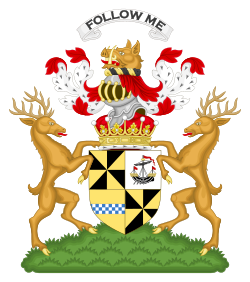
Marquess of Aberdeen and Temair, in the County of Aberdeen, in the County of Meath and in the County of Argyll, is a title in the Peerage of the United Kingdom. It was created on 4 January 1916 for John Hamilton-Gordon, 7th Earl of Aberdeen.

Clan Campbell is a Highland Scottish clan, historically one of the largest and most powerful of the Highland clans. The Clan Campbell lands are in Argyll and within their lands lies Ben Cruachan. The chief of the clan became Earl of Argyll and later Duke of Argyll.

Duke of Argyll is a title created in the peerage of Scotland in 1701 and in the peerage of the United Kingdom in 1892. The earls, marquesses, and dukes of Argyll were for several centuries among the most powerful noble families in Scotland. As such, they played a major role in Scottish history throughout the 16th, 17th, and 18th centuries. The Duke of Argyll also holds the hereditary titles of chief of Clan Campbell and Master of the Household of Scotland.
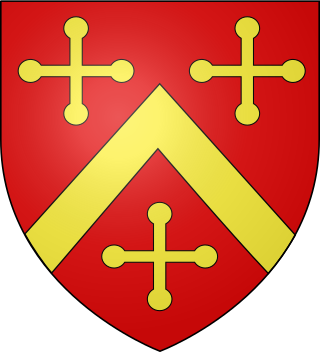
Earl of Holland was a title in the Peerage of England. It was created in 1624 for Henry Rich, 1st Baron Kensington. He was the younger son of Robert Rich, 1st Earl of Warwick, and had already been created Baron Kensington in 1623, also in the Peerage of England, having married Isabelle Cope, daughter and sole heiress of Sir Walter Cope (c.1553-1614), of Cope Castle in Kensington, Middlesex. His eldest son, the second Earl, succeeded his first cousin as fifth Earl of Warwick in 1673. All the titles became extinct on the death of the eighth Earl of Warwick and fifth Earl of Holland in 1759.

Earl of Caithness is a title that has been created several times in the Peerage of Scotland, and it has a very complex history. Its first grant, in the modern sense as to have been counted in strict lists of peerages, is now generally held to have taken place in favor of Maol Íosa V, Earl of Strathearn, in 1334, although in the true circumstances of 14th century, this presumably was just a recognition of his hereditary right to the ancient earldom/mormaership of Caithness. The next year, however, all of his titles were declared forfeit for treason.

Marquess of Hastings was a title in the Peerage of the United Kingdom. It was created on 6 December 1816 for Francis Rawdon-Hastings, 2nd Earl of Moira.

Kilchurn Castle is a ruined structure on a rocky peninsula at the northeastern end of Loch Awe, in Argyll and Bute, Scotland. It was first constructed in the mid-15th century as the base of the Campbells of Glenorchy, who extended both the castle and their territory in the area over the next 150 years. After the Campbells became Earls of Breadalbane and moved to Taymouth Castle, Kilchurn fell out of use and was in ruins by 1770. It is now in the care of Historic Environment Scotland and is open to the public in summer.

John Campbell, 1st Earl of Breadalbane and Holland, known as Sir John Campbell, 5th Baronet from 1670 to 1681, was a member of Scottish nobility during the Glorious Revolution and Jacobite risings and also known as "Slippery John". An astutely political man, Campbell was one of the men implicated in the Massacre of Glencoe.
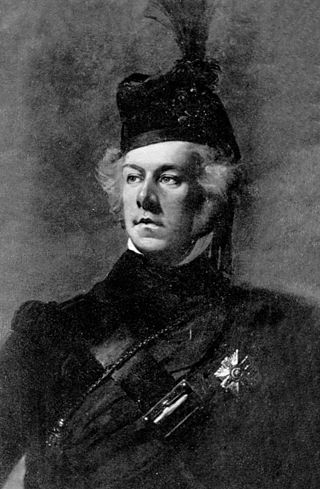
John Campbell, 2nd Marquess of Breadalbane,, styled Lord Glenorchy until 1831 and as Earl of Ormelie from 1831 to 1834, was a Scottish nobleman and Liberal politician.

Gavin Campbell, 1st Marquess of Breadalbane,, styled as Lord Glenorchy between 1862 and 1871 and as the Earl of Breadalbane and Holland between 1871 and 1885, was a Scottish nobleman and Liberal politician.

Baron Carteret is a title that has been created twice in British history, once in the Peerage of England and once in the Peerage of Great Britain. The first creation came into the Peerage of England in 1681 when the fourteen-year-old Sir George Carteret, 2nd Baronet, was made Baron Carteret, of Hawnes in the County of Bedford. The peerage was originally proposed for his grandfather Sir George Carteret, 1st Baronet, a celebrated royalist statesman, but he died before he was granted the title and as his eldest son, Philip, predeceased him, it was eventually bestowed on his grandson, George, with remainder to the latter's brothers. The Baronetcy, of Metesches in the Island of Jersey, had been created for George Carteret in the Baronetage of England on 9 May 1645. Lord Carteret married Lady Grace Granville, daughter of John Granville, 1st Earl of Bath. In 1715 Lady Grace was raised to the Peerage of Great Britain in her own right as Viscountess Carteret and Countess Granville. Lord Carteret and Lady Granville were both succeeded by their son John Carteret, the second Baron and second Earl. The titles became extinct on the death of the latter's son Robert Carteret, the third Earl, in 1776.

Taymouth Castle is situated to the north-east of the village of Kenmore, Perth and Kinross, in the Highlands of Scotland, in an estate which encompasses 450 acres (180 ha). It lies on the south bank of the River Tay, about 1 mile (1.6 km) from Loch Tay, in the heartland of the Grampian Mountains. Taymouth is bordered on two sides by mountain ranges, by Loch Tay on the third and by the confluence of the rivers Lyon and Tay on the fourth.

Clan Macnab is a Highland Scottish clan.
Lieutenant General Colin Campbell was Lieutenant Governor of Gibraltar.

Lieutenant-General John Campbell, 1st Marquess of Breadalbane FRS, known as John Campbell until 1782 and as The Earl of Breadalbane and Holland between 1782 and 1831, was a Scottish soldier and landowner.
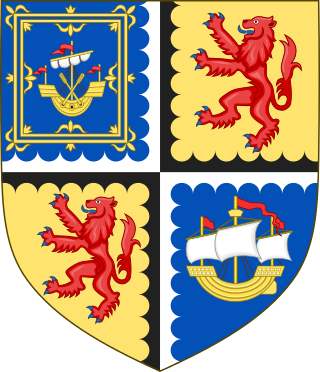
George Sinclair was a Scottish nobleman, 6th Earl of Caithness, and chief of the Clan Sinclair, a Scottish clan of the Scottish Highlands.

George Sinclair, previously of Keiss, died 1698, was a Scottish nobleman, 7th Earl of Caithness and chief of the Clan Sinclair, a Scottish clan of the Scottish Highlands.

Sir Duncan Campbell, 1st Baronet of Glenorchy (1545-1631) was a powerful Clan Campbell chieftain, landowner, courtier and favourite of Queen Anne of Denmark. He was the progenitor of the Earls of Breadalbane and Holland.

Sir Robert Campbell, 3rd Baronet of Glenorchy was a Scottish nobleman and landowner, the 9th Laird of Glenorchy and Glenfalloch.
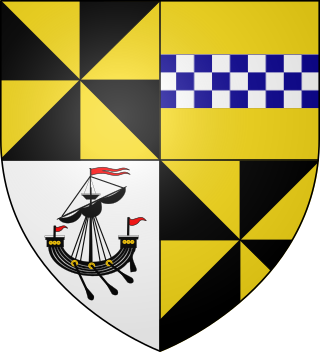
The Campbell baronetcy, of Glenorchy in the County of Perth, was created in the Baronetage of Nova Scotia on 29 May 1625 for the courtier Duncan Campbell, Laird of Glenorchy. Known as "Black Duncan", he was a favourite of Queen Anne of Denmark and had earlier represented Argyll in the Scottish Parliament. He was a descendant of Sir Colin Campbell, 1st Laird of Glenorchy, younger son of Duncan Campbell, 1st Lord Campbell, ancestor of the Dukes of Argyll. The third and fourth Baronets were also members of the Scottish Parliament for Argyll. The fifth Baronet was created Earl of Breadalbane and Holland in 1681.
